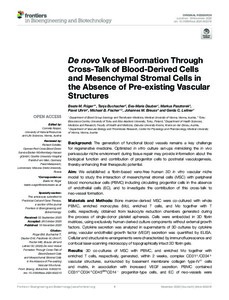| dc.contributor.author | Pavel Uhrin | |
| dc.contributor.author | Johannes M. Breuss | |
| dc.contributor.author | Markus Pasztorek | |
| dc.contributor.author | Beate M. Rüger | |
| dc.contributor.author | Eva-Maria Dauber | |
| dc.contributor.author | Gerda C. Leitner | |
| dc.contributor.author | Michael B. Fischer | |
| dc.contributor.author | Tanja Buchacher | |
| dc.date.accessioned | 2022-10-28T14:21:36Z | |
| dc.date.available | 2022-10-28T14:21:36Z | |
| dc.identifier.uri | https://www.utupub.fi/handle/10024/170893 | |
| dc.description.abstract | Background: The generation of functional blood vessels remains a key challenge for regenerative medicine. Optimized in vitro culture set-ups mimicking the in vivo perivascular niche environment during tissue repair may provide information about the biological function and contribution of progenitor cells to postnatal vasculogenesis, thereby enhancing their therapeutic potential. Aim: We established a fibrin-based xeno-free human 3D in vitro vascular niche model to study the interaction of mesenchymal stromal cells (MSC) with peripheral blood mononuclear cells (PBMC) including circulating progenitor cells in the absence of endothelial cells (EC), and to investigate the contribution of this cross-talk to neo-vessel formation. Materials and Methods: Bone marrow-derived MSC were co-cultured with whole PBMC, enriched monocytes (Mo), enriched T cells, and Mo together with T cells, respectively, obtained from leukocyte reduction chambers generated during the process of single-donor platelet apheresis. Cells were embedded in 3D fibrin matrices, using exclusively human-derived culture components without external growth factors. Cytokine secretion was analyzed in supernatants of 3D cultures by cytokine array, vascular endothelial growth factor (VEGF) secretion was quantified by ELISA. Cellular and structural re-arrangements were characterized by immunofluorescence and confocal laser-scanning microscopy of topographically intact 3D fibrin gels. Results: 3D co-cultures of MSC with PBMC, and enriched Mo together with enriched T cells, respectively, generated, within 2 weeks, complex CD31C /CD34C vascular structures, surrounded by basement membrane collagen type-IVC cells and matrix, in association with increased VEGF secretion. PBMC contained CD31C CD34CCD45dimCD14 progenitor-type cells, and EC of neo-vessels were PBMC-derived. Vascular structures showed intraluminal CD45C cells that underwent apoptosis thereby creating a lumen. Cross-talk of MSC with enriched Mo provided a proangiogenic paracrine environment. MSC co-cultured with enriched T cells formed "cellin-cell" structures generated through internalization of T cells by CD31C CD45dim = cells. No vascular structures were detected in co-cultures of MSC with either Mo or T cells. Conclusion: Our xeno-free 3D in vitro vascular niche model demonstrates that a complex synergistic network of cellular, extracellular and paracrine cross-talk can contribute to de novo vascular development through self-organization via co-operation of immune cells with blood-derived progenitor cells and MSC, and thereby may open a new perspective for advanced vascular tissue engineering in regenerative medicine. | |
| dc.language.iso | en | |
| dc.publisher | FRONTIERS MEDIA SA | |
| dc.title | De novo Vessel Formation Through Cross-Talk of Blood-Derived Cells and Mesenchymal Stromal Cells in the Absence of Pre-existing Vascular Structures | |
| dc.identifier.urn | URN:NBN:fi-fe2021042826228 | |
| dc.relation.volume | 8 | |
| dc.contributor.organization | fi=Turun biotiedekeskus|en=Turku Bioscience Centre| | |
| dc.contributor.organization-code | 2609201 | |
| dc.converis.publication-id | 50950660 | |
| dc.converis.url | https://research.utu.fi/converis/portal/Publication/50950660 | |
| dc.identifier.eissn | 2296-4185 | |
| dc.identifier.jour-issn | 2296-4185 | |
| dc.okm.affiliatedauthor | Buchacher, Tanja | |
| dc.okm.discipline | 1182 Biochemistry, cell and molecular biology | en_GB |
| dc.okm.discipline | 1182 Biokemia, solu- ja molekyylibiologia | fi_FI |
| dc.okm.internationalcopublication | international co-publication | |
| dc.okm.internationality | International publication | |
| dc.okm.type | Journal article | |
| dc.publisher.country | Switzerland | en_GB |
| dc.publisher.country | Sveitsi | fi_FI |
| dc.publisher.country-code | CH | |
| dc.relation.articlenumber | ARTN 602210 | |
| dc.relation.doi | 10.3389/fbioe.2020.602210 | |
| dc.relation.ispartofjournal | Frontiers in Bioengineering and Biotechnology | |
| dc.year.issued | 2020 | |
